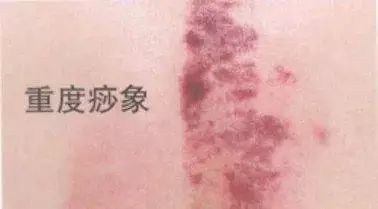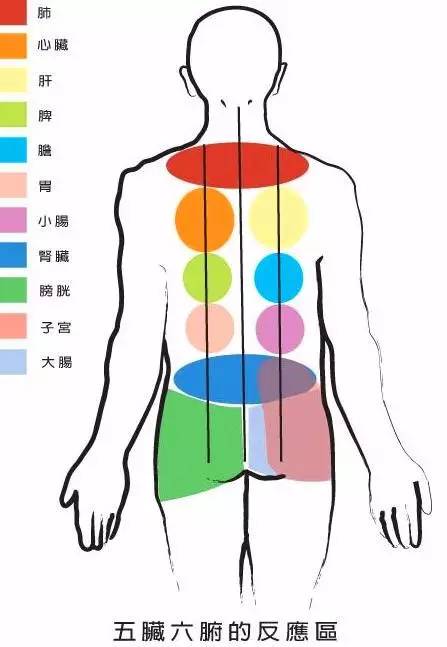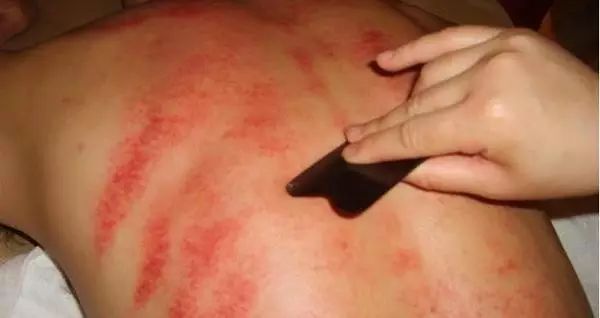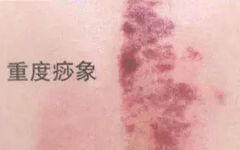Inheriting Traditional Chinese Medicine culture and cultivating TCM talents.
Hope more people can share with friends around them, so that every Chinese can learn about TCM and understand it.
According to TCM theory, the meridians in the human body are like an intricate traffic network, connecting various organs and facilitating the flow of Qi and blood. Guasha can promote the circulation of Qi and blood, expelling toxins from the body, and the marks left by guasha reflect different health conditions. The analysis can be conducted through the following methods:

1. Observe the Color
1. Red — indicates blood heat, dryness, and a tendency for inflammation and irritability;
2. Purple-red — suggests coldness has entered the body, affecting the internal organs only superficially;
3. Purple — indicates cold has penetrated the internal organs, leading to conditions such as stomach cold and uterine cold;
4. Purple-black — signifies cold has entered the spleen and heart, indicating a preparation for illness;
5. Black — indicates severe cold has infiltrated the internal organs, suggesting illness.

2. Observe the Area
1. Occipital Region
Reflects issues in the head and neck. If there are abnormal shapes and tender points in this area, it may indicate headaches, cervical bone spurs, hypertension, or pharyngitis.
2. Spinal Area
Represents sleep; poor sleep quality.
3. Bilateral Shoulder and Back Area
Reflects shoulder issues. (1) If there are tender points in this area, it may indicate headaches, shoulder pain, stiff neck, limb soreness, and eye pain;
(2) If purple marks appear, check for rheumatism or existing rheumatism;
(3) If the muscles of the large plate are overly tight with red spots, it may indicate shoulder periarthritis, with heavier marks on the right shoulder indicating desk work-related issues, while marks on the left shoulder suggest overthinking.
4. Heart and Lung Area (Thoracic Vertebrae 1-5, 6)
Reflects respiratory issues.
(1) If there are tenderness, stiffness, and red spots in this area, it may indicate colds, chest tightness, or insufficient heart and lung function;
(2) When heart and lung heat is present: easy thirst at night, dry cough; forehead prone to acne, skin on the forehead tends to be dry; irritability, severe cases may lead to nosebleeds; tongue is pointed, body of the tongue is red, prominent cheekbones may flush, palms may feel hot, lips may appear red, prone to spontaneous sweating (sweating even while sitting);
(3) When heart and lung function is deficient, the forehead may show fine lines, skin may be dry, lips may appear pale, insufficient Zheng Qi, speaking may require effort but still be quiet, prone to shortness of breath, may develop rhinitis, complexion may be pale, prone to night sweats (sweating secretly during sleep).

5. Spleen and Stomach Area (8, 9-11, 12)
Reflects digestive issues.
(1) If there are abnormalities, purple-black color or tender points and swelling, along with lower back pain, it may indicate diseases caused by poor liver function.
(2) If the spleen is weak, the eye circles may appear purple-red, skin may be dull and lack luster, pale complexion, prone to sagging, dry lips, peeling, bland taste, weight loss, and weakness, prone to dizziness;
(3) If the spleen is damp, water retention may occur, leading to a yellowish complexion, dark circles, acne, rosacea, upper body obesity, tongue may have teeth marks, and tongue coating may be pale.
(4) If the stomach is weak, dark circles may appear black, poor digestion, thinness, tongue may be dry and red, sticky, prone to thirst, and in severe cases, may have no tongue coating.
6. Liver and Gallbladder Area (5, 6-8, 9)
Reflects detoxification issues.
If there are tender points, abnormal spots, stiffness, pain, swelling, and purple-black color in this area, it may indicate indigestion, gastrointestinal bloating, acute or chronic gastroenteritis, and lower back pain.
7. Lumbar and Kidney Area (12-Lumbar 5)
Reflects endocrine issues.
(1) If there are tender points, stiffness, swelling, and purple-black color in this area, it may indicate cystitis, kidney deficiency, kidney dysfunction, diabetes, edema, lower back pain, frequent urination, and lumbar strain;
(2) Excessive secretion of male hormones: prone to acne around the mouth, coarse hair, excessive oil secretion, irritability, prone to thirst, and heat in the internal organs;
(3) Excessive secretion of female hormones: skin around the mouth may appear yellow, dry skin, slightly yellow complexion, lack of luster, prone to spots, irritability, and may develop menopausal syndrome.
8. Sacral Area If this area shows dark skin color, soreness, and swelling, it may indicate sciatica, menstrual irregularities, or uterine inflammation.
9. Scapular and Limb Area If this area shows abnormal shapes, tender points, and swelling, it may indicate limb diseases, knee pain, and limb swelling.

3. Observe the Shape
1. Flake-shaped — superficial, indicating issues only at the surface;
2. Small dots — damp-heat or cold-damp, representing accumulation over time; if not expelled, may lead to internal wind-damp or arthritis;
3. Medium dots — pathological precursors;
4. Large dots — reaction of the disease focus;
5. Blisters — indicate that wind-damp or internal wind-damp has formed.
Disclaimer: The content of this article, if it involves formulas or therapies, is for reference only. Please do not use it indiscriminately. The article and images are sourced from the internet; if there is any infringement, please contact for removal.
Share with those who care.
The more people see it, the more health there is!
Today's Recommendation

